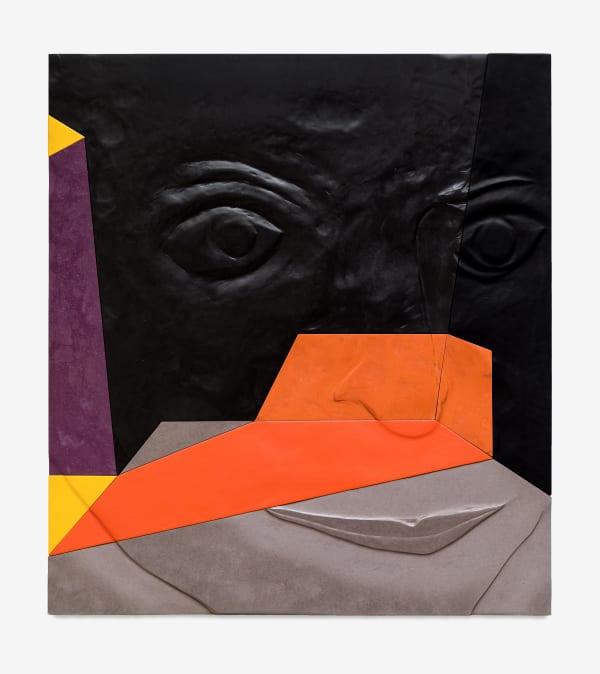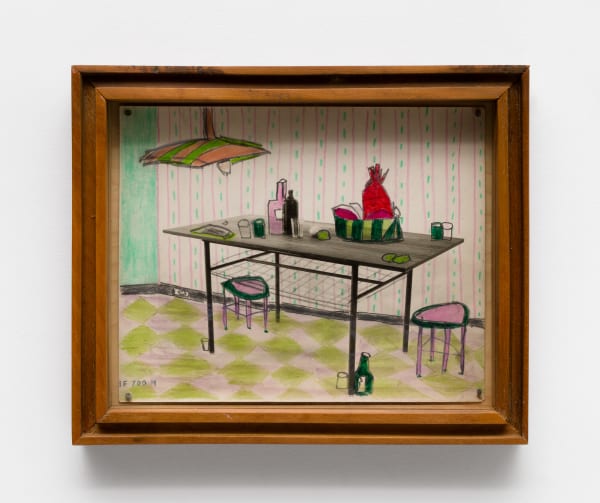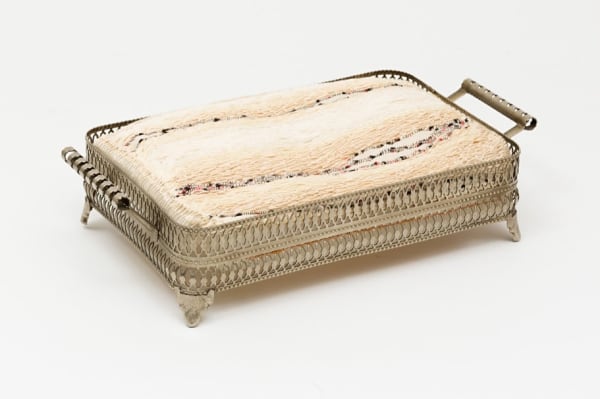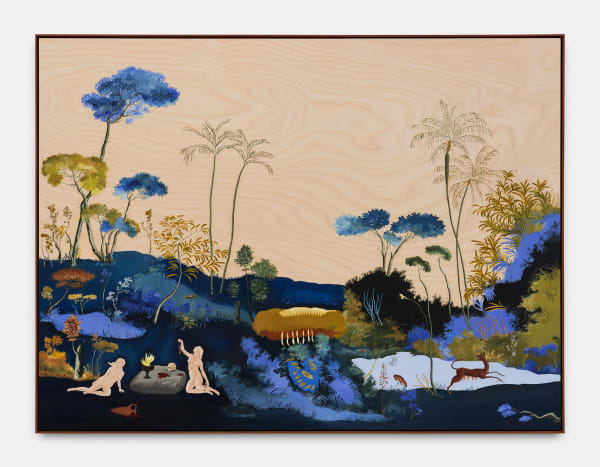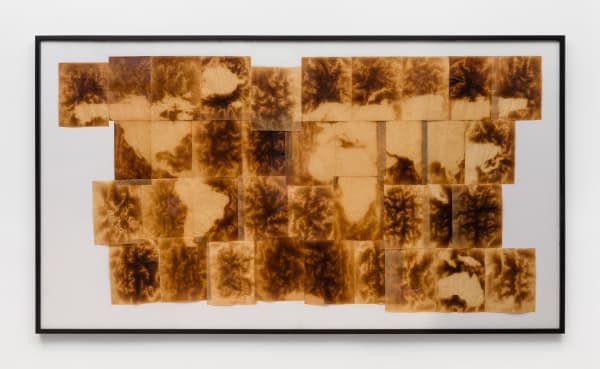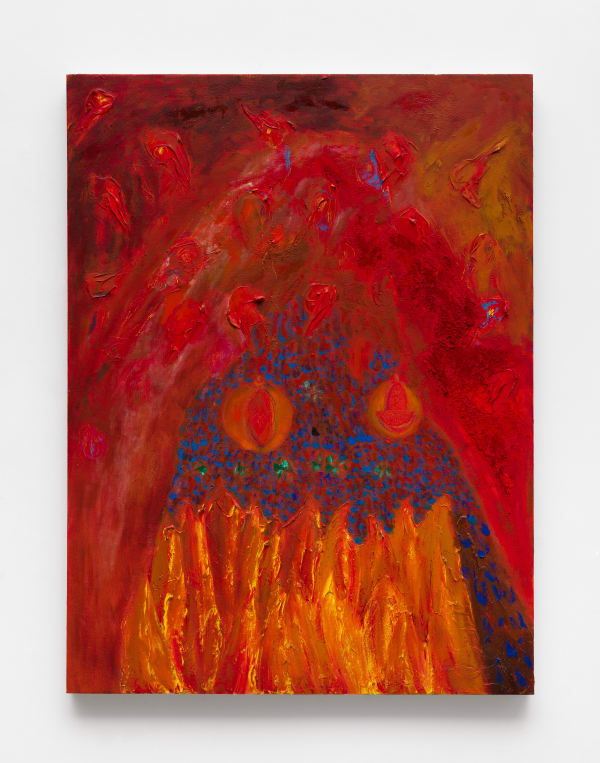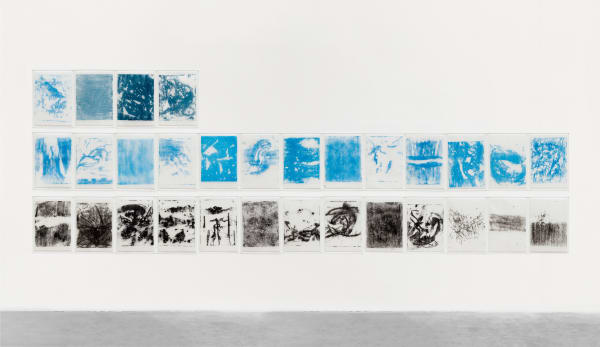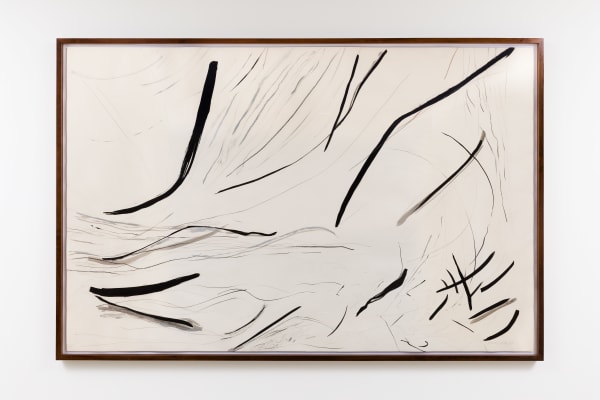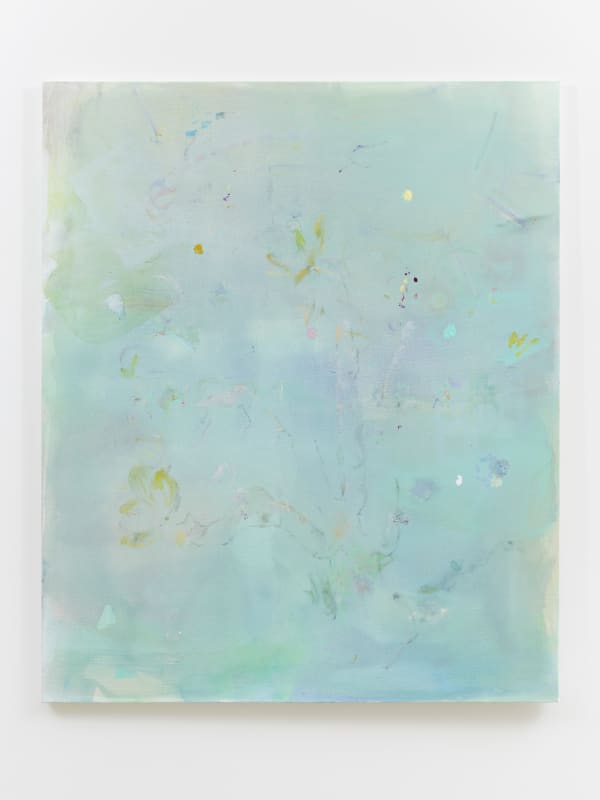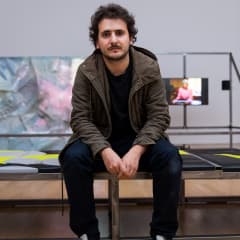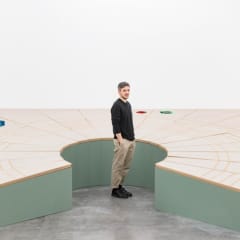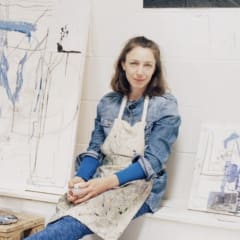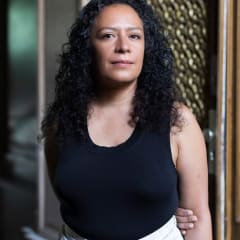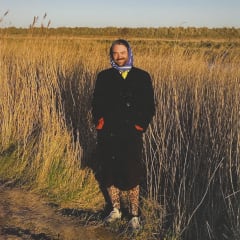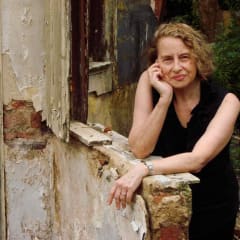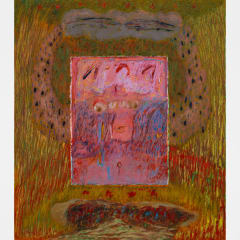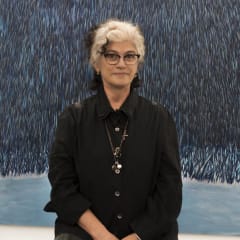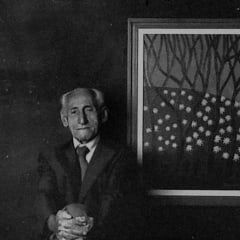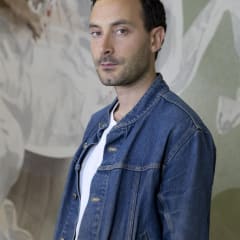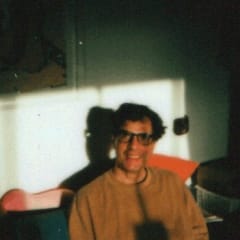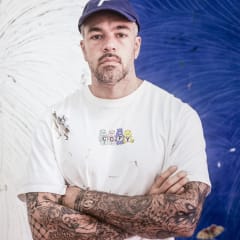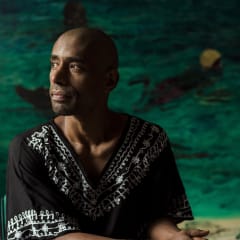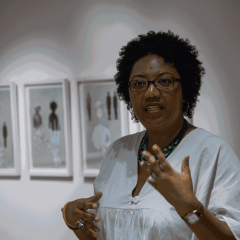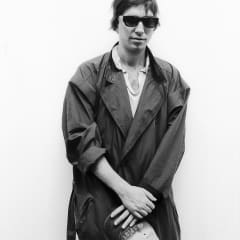Linhas Tortas Curated by Diana Campbell
Past exhibition
Overview
Linhas Tortas is a multi-venue international group exhibition that celebrates the entanglements of journeys and the power of storytelling, marking a decade of Mendes Wood DM. Inspired by the Brazilian aphorism “deus escreve certo por linhas tortas”, which literally translates to “god writes straight with crooked lines” and metaphorically to “god works in mysterious ways”, the show follows complex trails (of thought and of life) that unfold when one sets off with intention but without an end in sight. It takes paths that are not driven by expediency or efficiency, not optimized by supply and demand, but rather ones that avoid the many shortcuts blazed by capitalist and/or colonial forces to better the few at the expense of the many. It questions who had the right to write history, and posits new ways to (re)inscribe profound perspectives and systems of being that were deliberately obscured from view.
While many of the 100+ works of art in the show formally contain curving lines, including the beguiling out-of-this-universe painted landscapes of Marina Perez Simão, Ayesha Sultana’s poetic abstract paintings of industrial geometry and entropy, and Hana Miletić’s woven depictions of the everyday ingenuity of human repair in Brazil and Senegal, Linhas Tortas does not take the aphorism which inspires its title at face value.
Linhas Tortas questions why a singular god who we imagine as male has the power to write human histories; the power of writing and artists who use writing and text in their work; and also the violence of writing (as well as naming) in destroying traces of other knowledge systems, such as those found in oral and matrilineal cultures. Rosana Paulino deconstructs the production and dissemination of racist theories that served as justification for European colonialism and the slave trade, including those found in religious texts such as the Bible which bestowed Adam with the power to name. Castiel Vitorino Brasileiro also gives name to traumas bestowed by colonialism so that a path forward for ancestral knowledge might open up.
Shilpa Gupta’s work traces individuals who changed their last names either to succeed, or to survive, and Linhas Tortas also sheds light on the many artists who have changed the names with which they sign their work or worked with aliases as part of their search for artistic freedom, such as Bruce Conner, Kishio Suga, Antonio Obá, Paulo Nazareth, Senga Nengudi, Naufus Ramírez-Figueroa, Paulo Nimer Pjota, and many others, many of whom employ the written word in their artistic practice. The exhibition also explores the role of writing in artistic practice, such as in the practices of Michael Dean, Lawrence Weiner, Alvaro Barrington, Iulia Nistor, Adriano Costa, Laure Prouvost, Lynda Benglis, and Etel Adnan, which contextualize the said and the unsaid in their unique artistic language.
Linhas Tortas also delves into transformational transnational encounters that have informed the practices of artists such as Pacita Abad, Daniel Steegmann Mangrané, Senga Nengudi, Antonio Dias, Antony Gormley, and many others. Following the idea of the journey, works by Torkwase Dyson, Rubem Valentim, and Paulo Nazareth look at the geometries of liberation that free marginalized people and belief systems from coordinates of oppression. Nazareth plots out coordinates between fact and fiction, between Palmares and Wakanda, to try to locate the condition of Brazil in the 21st Century.
Linhas Tortas celebrates how artists have collaborated with changes in their own life path/their physical ability to transform the way they make art, such as Anni Albers, Alma Allen, and Aleijadinho (evoked by Solange Pessoa). It draws out lines of artistic influence, such as in the work of Luc Tuymans and Lucas Arruda, or a collaboration between Paulo Monteiro, Erika Verzutti, and Adriano Costa that honors a foundry that they all work with as individual artists.
This show refutes a straight-line reading of the past in favor of unearthing an ongoing network of meandering lines that come together through the works of artists who markup and annotate the seemingly endless scrawl of history. “Life is a continual struggle to make sense of the world’s complexity. Knowledge is hard won, and so both spoken language and writing are ways of fixing and transmitting it,” writes Robert Moor in his exploration of the significance of paths and trails in contemporary life. Misunderstanding is a path to new outcomes; we find things as we get lost in translation and reorient how we fit into the world. Plotlines thicken as other voices and perspectives come into the picture. Our field of perception is both a guide and a limitation, bound by our sensory abilities, actions, and subjective memories; this field expands as we become aware of worlds that previously evaded our consciousness. Old worlds can only hold in new ones via hybridity.
Held in parallel to the programs active in Mendes Wood DM’s galleries in São Paulo, Brussels, and New York, the points connecting the many lines of thought in Linhas Tortas will be drawn across Mendes Wood DM's Barra Funda Warehouse, the surrounding neighborhood in Sao Paulo and Casa Iramaia. Designed by the Ukrainian-Brazilian architect Gregori Warchavchik – who is credited with building the first modernist house in Brazil in 1927-1928 – Casa Iramaia is a curved residence located in Jardim Europa that stands as an architectural masterpiece, emerging from the curving lines that defined a Brazilian national identity. The show also acknowledges the role that modernist architecture played in writing over the underlying social chaos that has shrouded the people whose labor built the country. Other masterpieces of modern architecture come into the show through works by Amie Siegel and Daniel Steegmann Mangrané who treat buildings as central characters in their work. Circulating between intimate domestic and expansive industrial spaces, the show is held together by the idea that lines of solidarity bound by commitment, trust, and friendship form a powerful, intangible currency that can enable radical change in previously unimaginable directions. Ones that aren’t straight.
- Words from the curator, Diana Campbell
Artists include: Pacita Abad, Etel Adnan, Anusha Alamgir, Anni Albers, Alma Allen, Lucas Arruda ,Silvia Bächli, Alvaro Barrington, Geraldo de Barros, Neïl Beloufa, Lynda Benglis, Huma Bhabha, Pim Blokker, Sofia Borges, Kasper Bosmans, Paloma Bosquê, Castiel Vitorino Brasileiro, Heidi Bucher, Varda Caivano, Nina Canell, Guglielmo Castelli, Amilcar de Castro, Willys de Castro, Nicole Chaput, Neha Choksi, Bruce Conner, Adriano Costa, Alexandre da Cunha, Annalee Davis, Michael Dean, Mariana Castillo Deball, Antonio Dias, Torkwase Dyson, Naufus Ramírez-Figueroa, Coco Fusco, Carolina Fusilier, Anna Bella Geiger, Madelynn Gingold, Sonia Gomes, Antony Gormley, Shilpa Gupta, Lawrence Abu Hamdan, Veronika Hapchenko, Josi, Sanam Khatibi, Matthew Lutz-Kinoy, Vojtěch Kovařík, Runo Lagomarsino, Mimi Lauter, Patricia Leite, Leonilson, Candice Lin, Paloma Contreras Lomas, Amadeo Luciano Lorenzato, Daniel Steegmann Mangrané, Calvin Marcus, Roberto Burle Marx, Cildo Meireles, Hana Miletić, Paulo Monteiro, Paulo Nazareth, Senga Nengudi, Iulia Nistor, Antonio Obá, Eduardo Ortega, Christodoulos Panayiotou, Lygia Pape, Rosana Paulino, Fernando Marques Penteado, Solange Pessoa, Saskia Pintelon, Paulo Nimer Pjota, Laure Prouvost, Leticia Ramos, Celso Renato, Luiz Roque, Giangiacomo Rossetti, Monica Sartori, Mira Schendel, Maaike Schoorel, Mira Schor, Paula Siebra, Amie Siegel, Sula Bermúdez-Silverman, Marina Perez Simão, Kishio Suga, Ayesha Sultana, Pol Taburet, Mario Garcia Torres, Tunga, Luc Tuymans, Rubem Valentim, Luana Vitra, Erika Verzutti (collaborative piece with Adriano Costa and Paulo Monteiro), Evelyn Taocheng Wang, Lawrence Weiner and Francesca Woodman.
While many of the 100+ works of art in the show formally contain curving lines, including the beguiling out-of-this-universe painted landscapes of Marina Perez Simão, Ayesha Sultana’s poetic abstract paintings of industrial geometry and entropy, and Hana Miletić’s woven depictions of the everyday ingenuity of human repair in Brazil and Senegal, Linhas Tortas does not take the aphorism which inspires its title at face value.
Linhas Tortas questions why a singular god who we imagine as male has the power to write human histories; the power of writing and artists who use writing and text in their work; and also the violence of writing (as well as naming) in destroying traces of other knowledge systems, such as those found in oral and matrilineal cultures. Rosana Paulino deconstructs the production and dissemination of racist theories that served as justification for European colonialism and the slave trade, including those found in religious texts such as the Bible which bestowed Adam with the power to name. Castiel Vitorino Brasileiro also gives name to traumas bestowed by colonialism so that a path forward for ancestral knowledge might open up.
Shilpa Gupta’s work traces individuals who changed their last names either to succeed, or to survive, and Linhas Tortas also sheds light on the many artists who have changed the names with which they sign their work or worked with aliases as part of their search for artistic freedom, such as Bruce Conner, Kishio Suga, Antonio Obá, Paulo Nazareth, Senga Nengudi, Naufus Ramírez-Figueroa, Paulo Nimer Pjota, and many others, many of whom employ the written word in their artistic practice. The exhibition also explores the role of writing in artistic practice, such as in the practices of Michael Dean, Lawrence Weiner, Alvaro Barrington, Iulia Nistor, Adriano Costa, Laure Prouvost, Lynda Benglis, and Etel Adnan, which contextualize the said and the unsaid in their unique artistic language.
Linhas Tortas also delves into transformational transnational encounters that have informed the practices of artists such as Pacita Abad, Daniel Steegmann Mangrané, Senga Nengudi, Antonio Dias, Antony Gormley, and many others. Following the idea of the journey, works by Torkwase Dyson, Rubem Valentim, and Paulo Nazareth look at the geometries of liberation that free marginalized people and belief systems from coordinates of oppression. Nazareth plots out coordinates between fact and fiction, between Palmares and Wakanda, to try to locate the condition of Brazil in the 21st Century.
Linhas Tortas celebrates how artists have collaborated with changes in their own life path/their physical ability to transform the way they make art, such as Anni Albers, Alma Allen, and Aleijadinho (evoked by Solange Pessoa). It draws out lines of artistic influence, such as in the work of Luc Tuymans and Lucas Arruda, or a collaboration between Paulo Monteiro, Erika Verzutti, and Adriano Costa that honors a foundry that they all work with as individual artists.
This show refutes a straight-line reading of the past in favor of unearthing an ongoing network of meandering lines that come together through the works of artists who markup and annotate the seemingly endless scrawl of history. “Life is a continual struggle to make sense of the world’s complexity. Knowledge is hard won, and so both spoken language and writing are ways of fixing and transmitting it,” writes Robert Moor in his exploration of the significance of paths and trails in contemporary life. Misunderstanding is a path to new outcomes; we find things as we get lost in translation and reorient how we fit into the world. Plotlines thicken as other voices and perspectives come into the picture. Our field of perception is both a guide and a limitation, bound by our sensory abilities, actions, and subjective memories; this field expands as we become aware of worlds that previously evaded our consciousness. Old worlds can only hold in new ones via hybridity.
Held in parallel to the programs active in Mendes Wood DM’s galleries in São Paulo, Brussels, and New York, the points connecting the many lines of thought in Linhas Tortas will be drawn across Mendes Wood DM's Barra Funda Warehouse, the surrounding neighborhood in Sao Paulo and Casa Iramaia. Designed by the Ukrainian-Brazilian architect Gregori Warchavchik – who is credited with building the first modernist house in Brazil in 1927-1928 – Casa Iramaia is a curved residence located in Jardim Europa that stands as an architectural masterpiece, emerging from the curving lines that defined a Brazilian national identity. The show also acknowledges the role that modernist architecture played in writing over the underlying social chaos that has shrouded the people whose labor built the country. Other masterpieces of modern architecture come into the show through works by Amie Siegel and Daniel Steegmann Mangrané who treat buildings as central characters in their work. Circulating between intimate domestic and expansive industrial spaces, the show is held together by the idea that lines of solidarity bound by commitment, trust, and friendship form a powerful, intangible currency that can enable radical change in previously unimaginable directions. Ones that aren’t straight.
- Words from the curator, Diana Campbell
Artists include: Pacita Abad, Etel Adnan, Anusha Alamgir, Anni Albers, Alma Allen, Lucas Arruda ,Silvia Bächli, Alvaro Barrington, Geraldo de Barros, Neïl Beloufa, Lynda Benglis, Huma Bhabha, Pim Blokker, Sofia Borges, Kasper Bosmans, Paloma Bosquê, Castiel Vitorino Brasileiro, Heidi Bucher, Varda Caivano, Nina Canell, Guglielmo Castelli, Amilcar de Castro, Willys de Castro, Nicole Chaput, Neha Choksi, Bruce Conner, Adriano Costa, Alexandre da Cunha, Annalee Davis, Michael Dean, Mariana Castillo Deball, Antonio Dias, Torkwase Dyson, Naufus Ramírez-Figueroa, Coco Fusco, Carolina Fusilier, Anna Bella Geiger, Madelynn Gingold, Sonia Gomes, Antony Gormley, Shilpa Gupta, Lawrence Abu Hamdan, Veronika Hapchenko, Josi, Sanam Khatibi, Matthew Lutz-Kinoy, Vojtěch Kovařík, Runo Lagomarsino, Mimi Lauter, Patricia Leite, Leonilson, Candice Lin, Paloma Contreras Lomas, Amadeo Luciano Lorenzato, Daniel Steegmann Mangrané, Calvin Marcus, Roberto Burle Marx, Cildo Meireles, Hana Miletić, Paulo Monteiro, Paulo Nazareth, Senga Nengudi, Iulia Nistor, Antonio Obá, Eduardo Ortega, Christodoulos Panayiotou, Lygia Pape, Rosana Paulino, Fernando Marques Penteado, Solange Pessoa, Saskia Pintelon, Paulo Nimer Pjota, Laure Prouvost, Leticia Ramos, Celso Renato, Luiz Roque, Giangiacomo Rossetti, Monica Sartori, Mira Schendel, Maaike Schoorel, Mira Schor, Paula Siebra, Amie Siegel, Sula Bermúdez-Silverman, Marina Perez Simão, Kishio Suga, Ayesha Sultana, Pol Taburet, Mario Garcia Torres, Tunga, Luc Tuymans, Rubem Valentim, Luana Vitra, Erika Verzutti (collaborative piece with Adriano Costa and Paulo Monteiro), Evelyn Taocheng Wang, Lawrence Weiner and Francesca Woodman.
Works
-
 Etel Adnan, Grenades, 2020
Etel Adnan, Grenades, 2020 -
 Anni Albers, Untitled | Sem título, 1982
Anni Albers, Untitled | Sem título, 1982 -
 Alma Allen, Not Yet Titled
Alma Allen, Not Yet Titled -
 Alma Allen, Not Yet Titled
Alma Allen, Not Yet Titled -
 Alma Allen, Not Yet Titled
Alma Allen, Not Yet Titled -
 Alma Allen, Not Yet Titled, 2022
Alma Allen, Not Yet Titled, 2022 -
 Lucas Arruda, Three days and three nights, from the Deserto-Modelo series, 2023
Lucas Arruda, Three days and three nights, from the Deserto-Modelo series, 2023 -
 Silvia Bächli, Untitled | Sem título, 2020
Silvia Bächli, Untitled | Sem título, 2020 -
 Silvia Bächli, Untitled | Sem título, 2020
Silvia Bächli, Untitled | Sem título, 2020 -
 Geraldo de Barros, “Fotoforma”, São Paulo, Brasil, 1949/2014
Geraldo de Barros, “Fotoforma”, São Paulo, Brasil, 1949/2014 -
 Neïl Beloufa, Aparelho de som, 2017
Neïl Beloufa, Aparelho de som, 2017 -
 Neïl Beloufa, Car - on shadow projected from a window, 2021
Neïl Beloufa, Car - on shadow projected from a window, 2021 -
 Neïl Beloufa, Person - on a square room at night, 2021
Neïl Beloufa, Person - on a square room at night, 2021 -
 Huma Bhabha, Listen to What I'm not Saying, 2021
Huma Bhabha, Listen to What I'm not Saying, 2021 -
 Pim Blokker, The one for Brazil, 2023
Pim Blokker, The one for Brazil, 2023 -
 Sofia Borges, Ovo para Magritte / Egg for Magritte | Metaphysical Collages For A Swamp series, 2017-2019
Sofia Borges, Ovo para Magritte / Egg for Magritte | Metaphysical Collages For A Swamp series, 2017-2019 -
 Kasper Bosmans, Legend: Holotype, 2023
Kasper Bosmans, Legend: Holotype, 2023 -
 Heidi Bucher, Untitled (dark floor piece from Villa Bleuler) Zürich, 1991
Heidi Bucher, Untitled (dark floor piece from Villa Bleuler) Zürich, 1991 -
 Varda Caivano, Untitled, 2022
Varda Caivano, Untitled, 2022 -
 Nina Canell, Bubble Cult, 2022
Nina Canell, Bubble Cult, 2022 -
 Amílcar De Castro, Untitled, from the Corte e Dobra series | Sem título, da série Corte e Dobra, n.d.
Amílcar De Castro, Untitled, from the Corte e Dobra series | Sem título, da série Corte e Dobra, n.d. -
 Alexandre da Cunha, Caçador, 2023
Alexandre da Cunha, Caçador, 2023 -
 Fernando Marques Penteado, A Casa 04, 2012
Fernando Marques Penteado, A Casa 04, 2012 -
 Fernando Marques Penteado, Souflê de champignon, Bancarrota series | Souflê de champignon, da série Bancarrota, 2002
Fernando Marques Penteado, Souflê de champignon, Bancarrota series | Souflê de champignon, da série Bancarrota, 2002 -
 Naufus Ramírez-Figueroa, Landscaping and paving of Brazil | Paisagismo e pavimentação do Brasil, 2023
Naufus Ramírez-Figueroa, Landscaping and paving of Brazil | Paisagismo e pavimentação do Brasil, 2023 -
 Lawrence Abu Hamdan, For the Otherwise Unaccounted, 2020
Lawrence Abu Hamdan, For the Otherwise Unaccounted, 2020 -
 Veronika Hapchenko, into the light, after Ivan Litovchenko, 2023
Veronika Hapchenko, into the light, after Ivan Litovchenko, 2023 -
 Josi, quara-dores series | da série: quara-dores, 2021
Josi, quara-dores series | da série: quara-dores, 2021 -
 Sanam Khatibi, Almost a country house party, 2023
Sanam Khatibi, Almost a country house party, 2023 -
 Eleonore Koch, Estudo para Palmeira Sonhando, 1993
Eleonore Koch, Estudo para Palmeira Sonhando, 1993 -
 Runo Lagomarsino, Mapa Mundi, 2021
Runo Lagomarsino, Mapa Mundi, 2021 -
 Mimi Lauter, Untitled | Sem título, 2022
Mimi Lauter, Untitled | Sem título, 2022 -
 Patricia Leite, Estrela que brilha, 2021
Patricia Leite, Estrela que brilha, 2021 -
 Patricia Leite, Untitled | Sem título, 1986
Patricia Leite, Untitled | Sem título, 1986 -
 José Leonilson, To be selective, 1990
José Leonilson, To be selective, 1990 -
 Candice Lin, Lithium-Induced Hallucination Station, 2023
Candice Lin, Lithium-Induced Hallucination Station, 2023 -
 Candice Lin, Taboo Demon, 2023
Candice Lin, Taboo Demon, 2023 -
 Candice Lin, Transition Demon, 2023
Candice Lin, Transition Demon, 2023 -
 Amadeo Luciano Lorenzato, Untitled | Sem título, 1992
Amadeo Luciano Lorenzato, Untitled | Sem título, 1992 -
 Daniel Steegmann Mangrané, Singing Lines, 2023
Daniel Steegmann Mangrané, Singing Lines, 2023 -
 Calvin Marcus, Untitled | Sem título, 2023
Calvin Marcus, Untitled | Sem título, 2023 -
 Calvin Marcus, Untitled | Sem título, 2023
Calvin Marcus, Untitled | Sem título, 2023 -
 Roberto Burle Marx, Untitled | Sem título, 1963
Roberto Burle Marx, Untitled | Sem título, 1963 -
 Roberto Burle Marx, Untitled | Sem título, 1964
Roberto Burle Marx, Untitled | Sem título, 1964 -
 Roberto Burle Marx, Untitled | Sem título, 1964
Roberto Burle Marx, Untitled | Sem título, 1964 -
 Roberto Burle Marx, Untitled | Sem título, n.d.
Roberto Burle Marx, Untitled | Sem título, n.d. -
 Roberto Burle Marx, Untitled | Sem título, n.d.
Roberto Burle Marx, Untitled | Sem título, n.d. -
 Hana Miletić, Materials, 2023
Hana Miletić, Materials, 2023 -
 Iulia Nistor, Blueprint, 2019
Iulia Nistor, Blueprint, 2019 -
 Iulia Nistor, Evidence L9 W9 A2, 2023
Iulia Nistor, Evidence L9 W9 A2, 2023 -
 Christodoulos Panayiotou, Untitled | Sem título, 2021
Christodoulos Panayiotou, Untitled | Sem título, 2021 -
 Solange Pessoa, Metaflor-Metaflora, 2023
Solange Pessoa, Metaflor-Metaflora, 2023 -
 Paulo Nimer Pjota, Psykter grego com cactos, 2023
Paulo Nimer Pjota, Psykter grego com cactos, 2023 -
 Monica Sartori, Untitled | Sem título, 1989
Monica Sartori, Untitled | Sem título, 1989 -
 Monica Sartori, Untitled | Sem título, 1989
Monica Sartori, Untitled | Sem título, 1989 -
 Maaike Schoorel, The one for Brazil, 2023
Maaike Schoorel, The one for Brazil, 2023 -
 Mira Schor, White Figure in the Woods, 1982
Mira Schor, White Figure in the Woods, 1982 -
 Paula Siebra, Rendeira, 2023
Paula Siebra, Rendeira, 2023 -
 Amie Siegel, Body Scripts (pgs. 241 - 243), 2015
Amie Siegel, Body Scripts (pgs. 241 - 243), 2015 -
 Marina Perez Simão, Untitled | Sem título, 2023
Marina Perez Simão, Untitled | Sem título, 2023 -
 Kishio Suga, Standing, 1969/2023
Kishio Suga, Standing, 1969/2023 -
 Mario Garcia Torres, TBC, n.d.
Mario Garcia Torres, TBC, n.d. -
 Tunga, Afinidades Eletivas, 2002
Tunga, Afinidades Eletivas, 2002 -
 Luc Tuymans, Slide, 2003
Luc Tuymans, Slide, 2003 -
 Evelyn Taocheng Wang, Puzzle Game With Different Objects Indicate Women's Tragedy Future, 2017
Evelyn Taocheng Wang, Puzzle Game With Different Objects Indicate Women's Tragedy Future, 2017 -
 Sula Bermudez-Silverman, Houyhnhnm, 2023
Sula Bermudez-Silverman, Houyhnhnm, 2023
Installation Views













